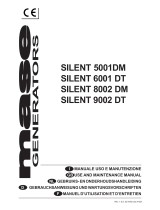
GENERATORS
- 19 -
IS 14.5T - 20T
GB
4.5 Components
The sea water intake system must
be separate from the one for the engines propelling
the boat.
1 - Direct sea intake 1/2"
If the unit is installed more than 1
metre above the water-line, a check valve should be
fitted after the sea intake (fig.10, ref. 1) to prevent the
water circuit emptying when the motor is off. If this
empties, the rotor of the water pump might be damaged
during start up; for the same reason, when the unit is
first started up, the suction tube from the valve to the
pump should be filled manually.
2 - Ball tap (general) 1/2"
3 - Ball tap (drainage) 1/2"
This is used to drain the cooling system of the
electric generator for general maintenance or when a
long period of inactivity is expected.
4 - Water filter (can be inspected)
This must provide efficient protection for the cooling
circuit from the entrance of mud, sand and seaweed.
Rate of flow IS 14.5T- 20T 25/28 L/min.
The filter mesh should be very fine.
Mesh 2 - 470 micron is recommended, other sizes do
not give good filter performance.
5 - Anti-siphon valve: this is a valve that brings the
cooling circuit back to atmospheric pressure when
the motor is turned off, thus avoiding the formation of
siphons. It’s use obligatory when the base of the
generator group is under the water line, and it
must be positioned at least 50 cm. above sea level.
(see fig.5,7,9).
Anti-siphon valve must be inserted
between the inlet of the sea water pump and mixing
elbow as indicated in Fig.13.
The drainage duct of the anti-siphon valve must run
beneath the valve itself in order to prevent water
accumulating in the duct, which should always re-
main empty to allow air to pass through when the unit
is switched off. (see fig.11)
It is recommended that the drainage pipe from the anti-
siphon valve be fed into the bilge, as small amounts of
water might be drained through it during normal operation.
The cooling circuit is connected to the heat exchanger
pipe fitting as shown in Figure 12.
4.6 Drainage system
The flue gas/water drainage system of the generator
must be separate from that of the main motors
The length of the tube from the
highest point of the drain duct to the muffler should
not exceed 2 metres. This is to prevent the water left
in the drainage duct returning to the motor after
filling the tank muffler, when the unit is turned off.
1 - Muffler.
This dampens the noise of the drainage and stops the
water flowing back towards the motor. The muffler
should be installed no less than 1 metre away from
the generator and positioned at a height as per
fig.4,5,6,7,8,9.
2 - Silencer
This further reduces noise. It should be installed no
more than 1 metre from the sea drainage nozzle.
3 - Outboard drainage pipe.
This must be fitted in a position that is constantly
above sea level in all the vessel’s possible conditions
of use.
5 FUEL CIRCUIT
The unit is fed by diesel fuel through the tubes marked
“Fuel inlet”(fig.14 ref.2 ) and “fuel outlet” (fig.14 ref.3).
This latter is used for the return of the excess fuel. There
is no need for filters in connections to the fuel tank, since
the unit already contains a fuel filter; however it is
advisable to fit a tap onto the fuel supply line downstream
of the tank and a single-acting valve (check valve) to
prevent the fuel system emptying for any reason. Use a
valve with a 50 millibar opening. (Max head 0.8 mt.)
The fuel pipes should be in hydrocarbon-resistant rubber,
of inner diameter 8 mm.
For further information, read the
engine instruction manual, supplied by the engine
manufacturer.














